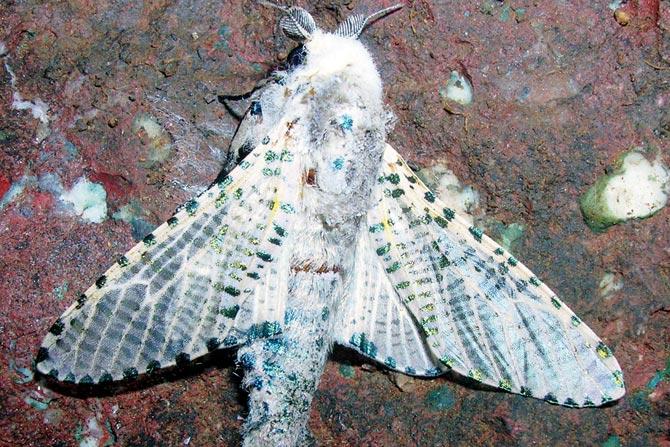The nocturnal cousin of the butterfly is ubiquitous but far less celebrated. National Moth Week is perfect time to learn all about the insect by signing up as citizen scientist

The painted handmaiden moth is a day-flying tiger moth. The caterpillars have red body hair. This one was spotted in Aarey Colony, Goregaon. Pic /Pradeep Dhivar
If you open the main door of your home one of these rainy nights, chances are, a moth along with its kith and kin will dart into your living room and perch themselves on a tubelight or the TV. These grey-brown creatures are often shoved into the "creepy crawlies" category that one may perhaps take a swat at. But their brightly coloured underwings hidden beneath the monochrome exterior are the perfect metaphor for the moth story — their numbers are 10 times the butterfly population, making these indicators of our habitat a worthy army of nature, but because their multi-hued cousins take the larger share of academic interest and common man's fascination, there is little awareness about them.
ADVERTISEMENT
The National Moth Week (NMW) was thus first observed in the last full week of July 2012 in the US, to encourage people to turn citizen scientists to observe and document the moth population in their locales, apart from involving more entomologists to study the insect. Since then, the initiative has reached more than 80 countries, including India. From its humble beginnings here, the country now has 50 registered events during the NMW, being observed this year from July 20 to 28, second only to the US.

Dr V Shubhalaxmi
But for a vast country like India with its rich biodiversity, this number is still far from encouraging, opines Dr V Shubhalaxmi, who after two decades of research, authored independent India's first field guide on Indian moths last year, and has earned the well-deserved title of India's first moth lady. The Mumbai-based entomologist and coordinator of the Indian NMW has organised a mothing event, as it is called, at a school in Kharghar, where with a simple set-up, she will help students and other wildlife enthusiasts identify and document the various species of moths in the Navi Mumbai locality. The iNaturewatch Foundation, of which she is the founder and managing trustee, will also provide guidance to those keen on setting up light sheets in their backyard to observe moths.
Moths deserve better
While the monochrome exterior of moths itself is a myth — the moon moth is milky white, and the name, crimson-spotted emerald moth, speaks for itself — the insect plays a significant role in the early detection of changes in nature. "Their absence or presence is an important trigger, but insects by and large don't feature in the narrative on environment protection," rues Dr Shubhalaxmi.

Indian Leopard Moth
With scientists estimating 150,000 to 500,000 moth species in the world, India alone has 12,000 to 15,000 of them. "In fact, Mumbai's biodiversity is so rich — several moth species can be spotted in Sanjay Gandhi National Park, while the Indian leopard moth was recorded in Maharashtra for the first time from Navi Mumbai — that there could be around 400 species in Mumbai alone. So, what we know at the moment is just the tip of the iceberg," she explains, recalling the challenges of recording the 772 species in her book in the absence of any resources after colonial records, and the strange job of having to coin common names of several species, as all that existed was their taxonomic nomenclature. "To break the ice with the common man, you ought to have common names for creatures. Take the Tussar silk moth or the silkworm for instance on which much of the Indian silk industry survives," she adds.
Know your moths

At the mothing event this Friday, Dr Shubhalaxmi will teach participants how moths are studied, identified and documented with the help of interactive exercises and a quiz. "All you need is a white sheet, a source of light, since many of them are nocturnal, and a sheltered outdoor site surrounded by greenery. But in nature, moths are guided by moonlight and artificial sources intersect with their paths. That's why we make sure we don't keep the light on all night long," she informs. "This week is really a reminder to appreciate moths."
The chequered snout moth is a possibly distasteful (read, poisonous for predators) moth as it feeds on milkweed plants. It is a common grass moth seen inside Sanjay Gandhi National Park. Pics/Isaac Kehimkar
The Indian leopard moth is a non-feeding adult moth that has a stem-boring caterpillar. In Maharashtra, it was first recorded from Navi Mumbai.

Crimson Spotted Emarald Moth
The crimson spotted emerald moth belongs to the geometer group, also known for its inch worms. Adults rest by hugging the surface.

Large eyed Owled moth
A mothing event makes use of light sheets. The large-eyed owl moth gets its common name from its wing patterns that make it look like an owl, thus protecting it from bird predators.
On July 26, 6 pm
At Vishwajyot High School, Sector 21, Kharghar.
Call 9987013144
Email info@inaturewatch.org
Catch up on all the latest Mumbai news, crime news, current affairs, and also a complete guide on Mumbai from food to things to do and events across the city here. Also download the new mid-day Android and iOS apps to get latest updates
 Subscribe today by clicking the link and stay updated with the latest news!" Click here!
Subscribe today by clicking the link and stay updated with the latest news!" Click here!






